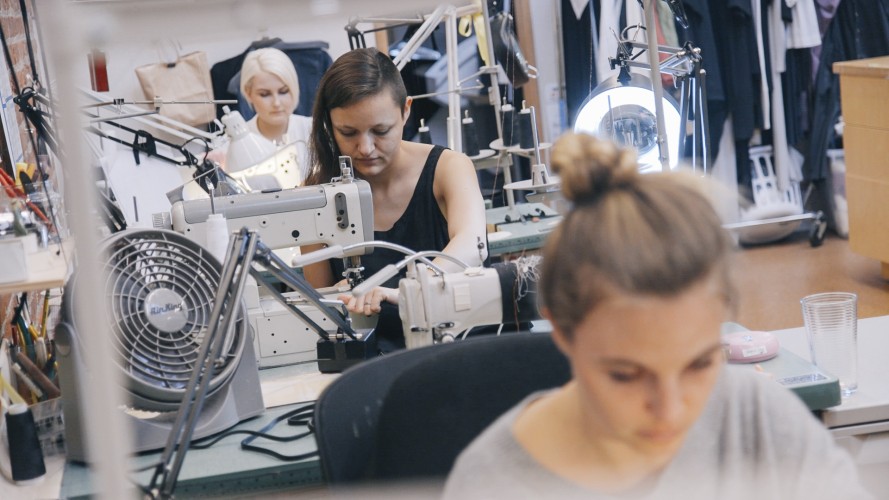May flew by as Eileen Fisher’s Social Innovators Teslin Doud, Carmen Gama and Lucy Jones jumped into production, which was filled with obstacles and challenges they had to maneuver. The trio decided it would be possible to make 500 units that will be for sale at the pop-up shop and big reveal at the end of July. The three started production with fittings and grading their patterns before allocating all of the damaged garments. They also calculated the metrics for each style (ie. 1 pant = box top, 3 tops = long tank) and started to sort through all the bags of damaged garments.
Teslin Doud: “During the past month’s development, we figured our sorting process would have to be specific, but we had no idea the challenges we would face during this allocation process. Sorting was so detailed that it was hard to keep track of. We were looking for garments as specific as size Large or bigger, wide leg, full length, and one-seamed pants in a specific fabric. Additionally, we had to check for stains, and match colors. At points, it felt a little discouraging to realize the system we had developed was a lot more cumbersome than we expected. To remedy this, we simply had to change our expectations. Once the specifications of garments per styles were figured out, those systems could live on; it was hard work up front, but well worth the time to make the production run smoothly. Additionally we had to change our perception of what fashion, specifically upcycled fashion, really is. Instead of going crazy trying to match colors, we realized that slight differences in colors or small imperfections are what make these new garments unique.”
Lucy Jones: “Once sorting had been completed, we would take the allocated garments and start a pre-cutting process, which involved deconstructing and pressing the pieces. We made a few assumptions about deconstructing, similar to the assumptions we made of sorting; we had no idea that preparing the garments would have to be re-evaluated due to the fact that each garment was slightly different to the one before it. It was a lot of work up-front to allow for a more streamlined production later on. We were careful to remove buttons, zippers, waistbands and slash the darts, since they would be stacked and therefore required to lay as flat as possible. We would pin the pattern piece on the stacks ready for the cutter to cut approximately 15 pieces at once. Some relatively simple garments only had three cutting steps: front, back and sleeve. But for the designs where we had engineered more seaming to make better use of the garments, the cutting stacks were more complex, with one design having up to 10 stacks for the 10 pattern pieces and filling an entire cutting table! Since we had pre-sorted the garments based on color and fabrics, we noticed a lot of the creativity begins at that step of the process and key design decisions are being made upfront, even though the garment is still a garment. It has been a learning curve to understand how a non-traditional process can operate in a traditional setting. We will be finishing approximately half of our garments in-house by the wonderful product development team and ourselves.”
Carmen Gama: “As we continue with production, ‘Multi-Tasking’ has become our core job. We are working in collaboration with various Eileen Fisher teams to prepare the garments for production, figure out costing, plan the final presentation, and, lastly, look into making new labels and hang tags exclusive for our garments. One of the tasks of the month is to figure out all the logistics that go behind labels and hangtags. Our challenge is to look into different ways to communicate our three different techniques –natural dying, disassembly and felting — along with the story behind our project in the most concise, effective and as clear way as possible through these labels.
We are working with the manufacturing team to understand the right copy on labeling regulations and care content for each of the fibers used in the capsule collection. As per the sewn in labels we decided to up cycle the labels from the ‘Chop’ garments that we use to make new clothes. For the hangtags, we are working with the writing team to create a new hangtag that reads Eileen Fisher, but is different enough from their main line and the Green Eileen label. Lastly, the graphics team is helping us set up the right layout and to choose environmentally friendly papers for our hangtags. It has been amazing to work with all these teams and help push the boundaries to get things done in a short period of time. They fondly call us the ‘Tess, Lucy and Carmen Effect.’”



